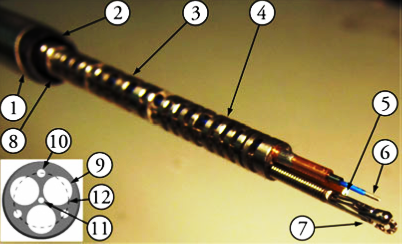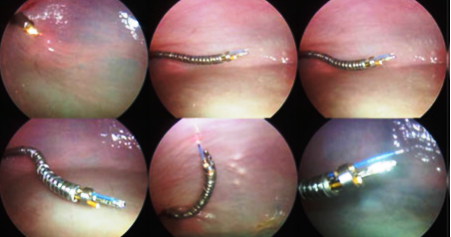This page describes some of our activity within an NIH-funded award #R21EB015623, which started on July 2013.
Motivation:
Based on National Cancer Institute statistics, bladder cancer acounted for 4.4% of all new cancer cases in 2013, rendering it the 6th most common one. However, it has the highest treatment costs per patient due to high recurrence rate partly associated with incomplete tumor resection on initial TUR. In addition, current surgical tool limitations hinder accurate and complete tumor resections and visualization; result in improper staging and increase rates of perforations and tumor recurrence.This project focuses on enabling higher precision, safer, and more dexterous resection and surveillance of bladder tumors. The proposed technology will reduce surgeon burden, improve resection accuracy, and hopefully reduce recurrence rates, trauma, and patient treatment cost.Recent Achievements:
Past Achievements:
A surgical robotic system has been designed and implemented ex-vivo. It is composed of a simple master inteface for remote operator control and a slave system for direct interaction/intervention with the patient's bladder. The system includes a dextrous continuum robot with access channels for simultaneous deployment of multiple visualization and surgical instruments. See Figure 1.
Fig. 1- Image of telesurgical setup in Bovine ex-vivo study
The slave is composed of actution unit and distal dextrous manipulator(snake). See Figure 2.
Its goal is deliver of intravesicular visualization and dextrous instrumentation. The DDM's goals are:1- facilitate surveilaence and surgical intervention, 2- obviate the nee to use suprapubic pressure to reach anterior aspects of the bladder, 3- facilitate control of the angle of approach w.r.t walls of the bladder.
The motion of DDM is provided by 7-DOF actuation unit. The unit provides linear motion for insertion of DDM into the bladder and for actuation of two continuum segments. The telemanipulation accuracy outside the bladder was estimated to be 0.48 mm.
Fig. 2- Image of the surgical slave DDM 1. Resectoscope outer Sheath, 2. Resectoscope inner sheath, 3. Proximal continuum segment, 4. Distal continuum segment, 5. Fiberscope, 6. Laser cautery fiber, 7. Biopsy forceps, 8. Insertion tube, Inset depicts a cross-section of DDM disks 9- Instrumentation channels, 10- Secondary backbone lumen, 11- Primary backbone lumen, 12- Pitch circle
A method was developed for constrained motion control of the slave inside the bladder. Virtual fixtures were designed and utilized in the configuration space of the continuum robot and a multi-task redundancy resolution scheme was used to exploit the DOFs of the robot based on task priority. Experimental results demonstrated the effectiveness of the proposed methodology in target different sections of the bladder. Fig. 3 illustrates overall control architecture of the surgical robotic system. See reference [2] for detailed treatment.
Fig. 3- Overall schematic diagram of the telerobotic system control architecture
An ex-vivo study of the system deployed in a bovine bladder demonstrated the utility of the system for surveilance and energy delivery under clinical conditions. The DDM was deployed into the bladder and moved within to visualize different sections based on operator commands (see Fig. 4). A 0.55 mm diameter probe encasing 200 micron holmium laser fiber was deployed through one of the channels and used to cauterize dyed target areas.More details on the design are mentioned in [4].
Fig. 4- DDM manipulated inside bovine bladder at various sections
The surgical slave went under a new revision to render it more suitable for the application at hand by addressing some of its limitations. The new design called TURBot uses a custom-made assembly to guide the continuum robot and visualizations through a sheath inside the bladder. We have conducted several in-vivo experiments on swines. Currently, we are finishing experiments on human bladder phantoms.Currently Active Personnel
- Nima Sarli starting in August 2013
- Giuseppe Del Giudice starting in February 2014
Former Personnel
- Roger Goldman 2009-2011
- Sarah Suh-Mclachlan 2009-2011
- Andrea Bajo 2011-2012
- Long Wang 2013
Publications
- Sarli, N., "Design, Modeling & Control of Continuum Robots & Dexterous Wrists with Applications to Transurethral Bladder Cancer Resection.", PhD dissertation, Vanderbilt University, Sep 2018.
- Sarli, N., Del Giudice, G., De, S., Dietrich, M. S., Herrell, S. D. and Simaan, N., "TURBot: a System for Robot-Assisted Transurethral Bladder Tumor Resection", IEEE/ASME Transactions on Mechatronics, Submitted.
- Sarli, N., Del Giudice, G., De, S., Dietrich, Mary S., Herrell, S. D. & Simaan, N (2018). "Preliminary Porcine in vivo Evaluation of a Telerobotic System for Transurethral Bladder Tumor Resection & Surveillance". Journal of Endourology, vol. 32, no. 6, June 2018.
- Sarli, N. & Simaan, N (2017). "Minimal Visual Occlusion Redundancy Resolution of Continuum Robots in Confined Spaces". In International Conference on Robotics and Intelligent Systems. Vancouver, Canada.
- Sarli, N., Del Giudice, G., Herrell, S. D. & Simaan, N. (2016). A Resectoscope for Robot-Assisted Transurethral Surgery. ASME Journal of Medical Devices, 2(10), 020911.
- Sarli, N., Marien, T., Mitchell, C. R., Del Giudice, G., Dietrich, M. S., Herrell, S. D. et al. (2016). Kinematic and Experimental Investigation of Manual Resection Tools for Transurethral Bladder Tumor Resection. The International Journal of Medical Robotics and Computer Assisted Surgery
- Del Giudice, G., Sarli, N., Herrell, S. D. & Simaan, N (2016). Design Considerations for Continuum Robot Actuation Units Enabling Dexterous Transurethral Bladder Cancer Resection. In International Design Engineering Technical Conferences and Computers and Information in Engineering Conference (ASME IDETC). Charlotte,NC,USA.
- S. D. Herrell, R. Webster, and N. Simaan, “Future robotic platforms in urologic surgery: recent developments.,” Current Opinions in Urology, vol. 24, no. 1, pp. 118–26, Jan. 2014.
- A. Bajo, R. B. Pickens, S. D. Herrell, and N. Simaan, “Constrained Motion Control of Multisegment Continuum Robots for Transurethral Bladder Resection and Surveillance,” ICRA’2013 IEEE International Conference on Robotics and Automation, pp. 5817-5822, 2013.
- Pickens, R., Bajo, A., Simaan, N., Herrell, S. D., “A Pilot Ex-Vivo Evaluation of a Telerobotic System for Transurethral Intervention and Surveillance”, Journal of Endourology, under review, 2013.
- Goldman, R.E., Bajo, A., MacLachlan, L. S., Pickens, R., Herrell D., Simaan, N., “Design and Performance Evaluation of a Minimally Invasive Telerobotic Platform for Transurethral Exploration and Intervention,” IEEE Transactions on Biomedical Engineering (TBME) special issue on Surgical Robotics,Vol. 60, No. 4., DOI: 10.1109/TBME.2012.2226031, PMID: 23144027, pp. 918 - 925, 2013.
- A. Bajo, R. Pickens, D. Herrell, N. Simaan, “A Pilot Ex-Vivo Evaluation of a Telerobotic System for Transurethral Intervention and Surveillance,” Proceedings of the Hamlyn Symposium on Medical Robotics, London, Jul. 1-2, 2012.
- Ryan B. Pickens, M.D., Andrea Bajo, Nabil Simaan, S. Duke Herrell, “Preliminary Testing of a Transurethral Dexterous Robotic System for Bladder Resection” presented at the 27th annual meeting of the Engineering & Urology Society, Atlanta GA, May 19, 2012.
- Goldman, R., Bajo, Andrea, Suh, L., Benson, M., Simaan, N., presented in the 2011 Annual Engineering and Urology Society annual meeting, May 14, Washington, DC, 2011.
Collaborators:
- Duke S. Herrell
- Mary Dietrich
- Christopher Ryan Mitchell
- Tracy Marien
- Smita De
Robot-Assisted Transurethral Resection of Bladder Tumors |





